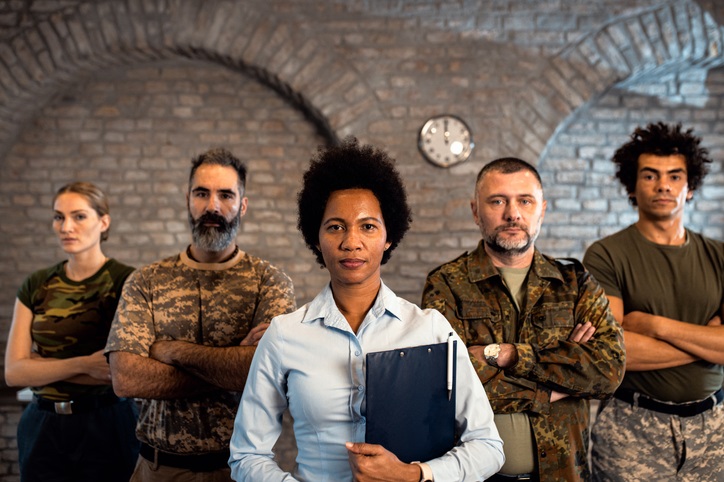
Summer 2023

Decreasing the Military-Civilian Gap: What Behavioral Medicine Researchers and Practitioners Need to Know About Veterans and Military Personnel
Chase A. Aycock, PsyD; Jennifer Fillo, PhD; & the Military & Veteran Health SIG
This year, 2023, marks 50 years of the United States operating with an all-volunteer military force. Since the last draft ended in 1973, the burden of protecting the security of the nation has fallen on fewer and fewer individuals. With fewer people serving, fewer Americans have direct ties to the military through family, friends, or neighbors (Schaeffer, 2021). This is causing a growing “military-civilian gap,” or lack of understanding of one another contributes to isolation and misrepresentation (Taylor et al., 2011). Given the dire need for effective behavioral interventions within this population, it is more important than ever for researchers, clinicians, and policy makers to educate themselves on the broad aspects of the social context and occupational demands of armed service. This brief article outlines a few key points that SBM members need to know about current and former service members.
Varieties of Armed Service
Veterans and service members have a range of experiences depending on when they served and the nature of that service. Surviving veterans likely served in either the Post-9/11 period, Gulf War, Vietnam Era, Korean War, or during peacetime (Vespa, 2020). Regardless of when military personnel served, or when they continue to serve, one can easily conceive of several ways in which the subculture, lifestyle, and occupational demands would vary substantially between a recently enlisted Army soldier in an air defense artillery battalion, a high-ranking intelligence officer in the Space Force, and a mid-career construction electrician in the Navy Reserve. Two individuals within the same career field and branch of the military can even have widely ranging experiences based on their rank or amount of time within the career field, their assignment, and concurrent national and global events. Further, deployment experiences vary widely in duration, location, safety, and mission. A service member may or may not request, desire, or expect a specific tasking, and they may deploy with an entire military unit or as an individual augmentee. Some current deployed installations have Wi-Fi, cell service, and many amenities; others are more austere with limited ability to communicate back home. A deployed unit may be composed of a mixture of Active Duty, Reserve, and National Guard members that may or may not be exposed to combat and/or indirect fire. Further, the nature of Veteran’s experiences while serving depends largely on the period during which they served, and the duration of their service. These myriad aspects of military service also interact with the intersectional social identities and individual differences of a given service member. “Military service” is a heterogeneous construct, and we must recognize the nuance to avoid stereotyping and misrepresentation.
Commonalities across Military and Veteran Experiences
At the same time, military service has some cross-cutting distinctive characteristics. Regardless of the branch, job, or era in which one serves, military personnel typically undergo a few weeks or months of initial service-specific training (“Boot Camp,” “Basic Officer Leadership Course,” etc.) followed by job-specific training (e.g., “Technical Training” or “A School”). In these initial training contexts as well as subsequent professional military education, service members are socialized to the hierarchical structure of the military as well as the expected standards for professional communication, behavior, and appearance. Each branch places a strong emphasis on specific institutional values, which emphasize courageous action, honorable and ethical conduct, and service to the nation over individual liberties. This latter concept about commitment and selfless service (language varies by branch) is distinct from the prevailing individualistic perspectives held within U.S. society. That is, service members are called upon to make necessary sacrifices for the sake of the mission and objectives of the broader organization. This may entail geographic separation from family members, suspending personal preferences and freedoms, and accepting undesirable postings and assignments across the world. Ultimately, these values and sacrifices are rooted back to the oath taken upon enlisting or commissioning to the Profession of Arms: i.e., “To support and defend the Constitution of the United States against all enemies, foreign and domestic” (Title 10, Chapter 31 §502). Additional unique aspects of military service include access to universal healthcare (i.e., “TRICARE”), requirements for fitness and occupational readiness, and are subject to the Uniform Code of Military Justice.
There are plenty of opportunities for behavioral medicine researchers and practitioners to have a meaningful impact in the military and veteran population. As with any unique community, however, it is important to understand the social and cultural context for those you are serving. We hope that some of these considerations have been useful in furthering the understanding or sparking the curiosity of like-minded colleagues. If you are interested to continue learning more about the Military and Veteran population, here are a few useful links:
Military and Veteran Culture and Experiences:
- Center for Deployment Psychology: https://deploymentpsych.org/military-culture
- VA Community Provider Toolkit: https://www.mentalhealth.va.gov/communityproviders/
- Military Family Research Institute: https://www.mfri.purdue.edu/
Population-based Surveys related to Military and Veteran Health:
- DoD Health Related Behavior Survey: https://www.rand.org/nsrd/projects/hrbs.html
- Millenium Cohort: https://www.millenniumcohort.org/
SBM Special Interest Group (SIG):
- Military & Veterans’ Health SIG: https://www.sbm.org/membership/special-interest-groups/military-and-veterans-health
The views expressed are those of the authors and do not reflect the official views or policy of the Department of Defense or its Components.
References
Enlistment Oath, Title 10, Chapter 31 § 502 (2006). https://uscode.house.gov/view.xhtml? req=granuleid:USC-prelim-title10-section502&num=0&edition=prelim
Schaeffer, K. (2021). The changing face of America’s veteran population. Pew Research Center. Retrieved June 1, 2023, from https://www.pewresearch.org/short-reads/2021/04/05/the-changing-face-of-americas-veteran-population/
Taylor, P., Morin, R., Parker, K., Cohn, D. V., Funk, C., & Mokrzycki, M. (2011). War and Sacrifice in the Post-9/11 Era. The Military-Civilian Gap. Pew Research Center.
Vespa, Jonathan E., “Those Who Served: America’s Veterans From World War II to the War on Terror,” ACS-43, American Community Survey Reports, U.S. Census Bureau, Washington, DC, 2020.